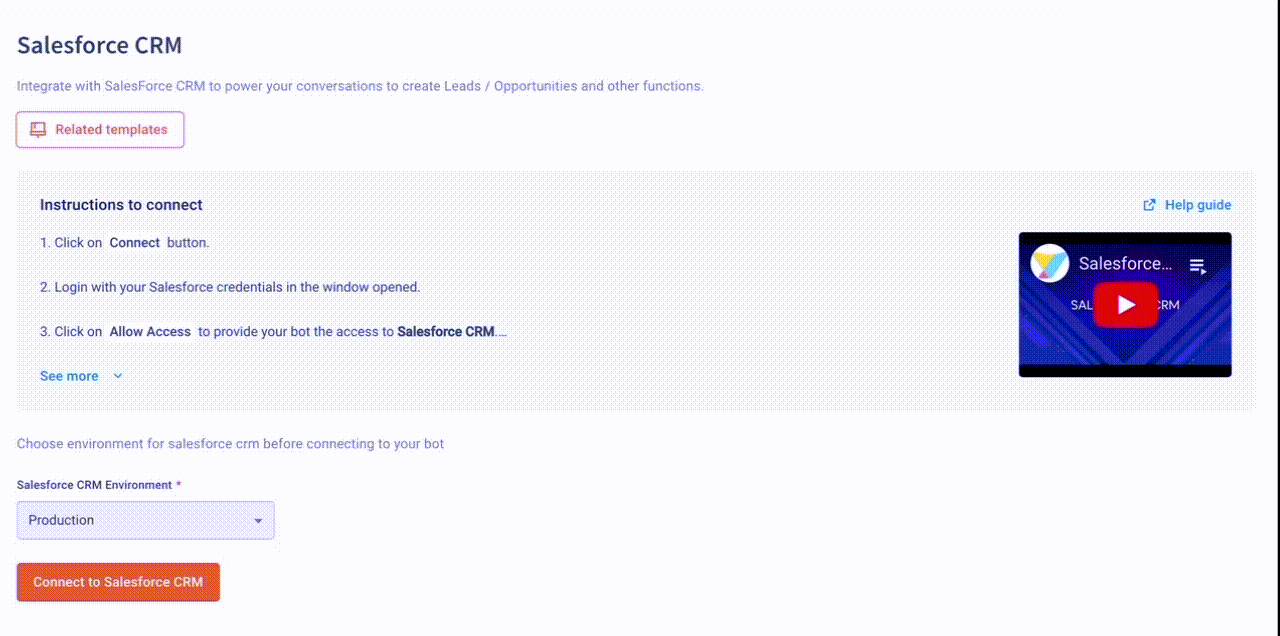Salesforce CRM
Salesforce is a cloud-based software company that provides a range of business solutions. At its core, Salesforce offers Customer Relationship Management (CRM) software, which helps businesses manage and analyze customer interactions and data. The CRM system allows companies to track sales, marketing efforts, customer service, and other aspects of their operations.
In addition to CRM, Salesforce has various subsidiaries and products that extend its capabilities. For instance, they offer live chat solutions to facilitate real-time customer support and engagement. Yellow.ai supports integration with Salesforce CRM and Salesforce Live Chat.
To configure Salesforce CRM, the user account must have Super Admin–level permissions.
Table of contents
- What Salesforce actions are available on Yellow.ai?
- How to connect Salesforce CRM with Yellow.ai?
- How to use Salesforce CRM from Yellow.ai?
Salesforce actions that can be managed from yellow.ai
After integrating with Salesforce CRM, you can perform the following tasks directly from the Yellow.ai platform:
| Action | Description |
|---|---|
| createRecord | Creates a record in the integrated Salesforce account. The following are the different types of available records: 1. Accounts 2. Contacts 3. Opportunities 4. Leads 5. Cases 6. Campaigns 7. Products and Price Books 8. Tasks 9. Events 10. Custom 11. Objects 12. Documents and Attachments |
| updateRecord | Updates a record in the integrated Salesforce account. |
| searchRecord | Looks for a particular info in the integrated Salesforce account. |
| Query by SQL | Query and retrieve data from the Salesforce database. You can create SQL queries by referring to the following links: Link 1 Link 2 |
| Get User Details by Owner ID | In Salesforce, each user has a unique identifier known as the Owner Id. This process involves using the Owner Id of a record (e.g., Account, Contact, or Opportunity) to fetch details about the user who owns that particular record. |
Connect Salesforce CRM with Yellow.ai
Prerequisites:
- An active Salesforce CRM account
- An active yellow.ai account
- Super Admin access
To connect your Salesforce CRM account with Yellow.ai, follow these steps:
-
On the left navigation bar, go to Extensions > Integrations.

-
Navigate to CRM > Salesforce CRM. Alternatively, you can use the Search box to find the integration app.

-
Choose a unique name for your Salesforce account and select the Salesforce CRM environment. It is recommended to use a name that reflects its purpose for improved usability.

-
Click Connect. You will see a pop-up screen to login with a list of accounts.
-
Choose the respective account and click Log in

-
If you have multiple accounts, click +Add account and follow the above mentioned steps to add each one. You can add a maximum of 15 accounts.

- In a two-tier environment, such as bots with only Development/Live environments, you can add account names only in the development mode. Once added and flows have been built, in the Live mode, you can only choose the account names and not edit them.
- In a three-tier environment, such as bots with Staging/Sandbox/Production modes, in Staging and Sandbox modes, you can add and edit new accounts. However, in Production, only the account details added in Staging will be available. You can only map in the production environment.
Manage your Salesforce CRM through bot conversations
To carry out a certain action in your Salesforce account, follow these steps:
-
Go to Automation and create a flow based on your requirement.

-
In whichever point you want the bot to access Salesforce, include the Salesforce CRM node. For that, drag the node connector, go to Integrations > Salesforce CRM.

-
In the Salesforce CRM node, fill in the following

- Account name: Choose the preferred Salesforce CRM account.
- Action: Choose the action to be performed.
- Select Objects: Choose the Salesforce CRM object in which the chosen action should be performed.
- Depending on the selected object, the corresponding fields will be shown. To collect this information from users, you must construct the flow accordingly and store the data in variables. These variables will then be used in this context.
- Each Salesforce action returns a response as a JSON object or an array. Store that response in a variable and pass that variable in a message node to display that response to the end user.
| Action | Syntax |
|---|---|
| To consume the JSON object as it is | {{variables.variable_name_object.choices.0.text}} |
| To access fields in JSON object response | {{variables.variable_name.field_name}} |
| To access array values | Use keys. For instance, to access the weather description from the below response, use{{variables.API_var.weather.0.description}} because the value is inside an array and is the first value (0th index). |
Sample response:
{
"coord": {
"lon": 77.2167,
"lat": 28.6667
},
"weather": [
{
"id": 761,
"main": "Dust",
"description": "dust",
"icon": "50d"
}
],
}
Supported Version
This integration will support the latest version's (52.0) releases. For more information on this, please click here.